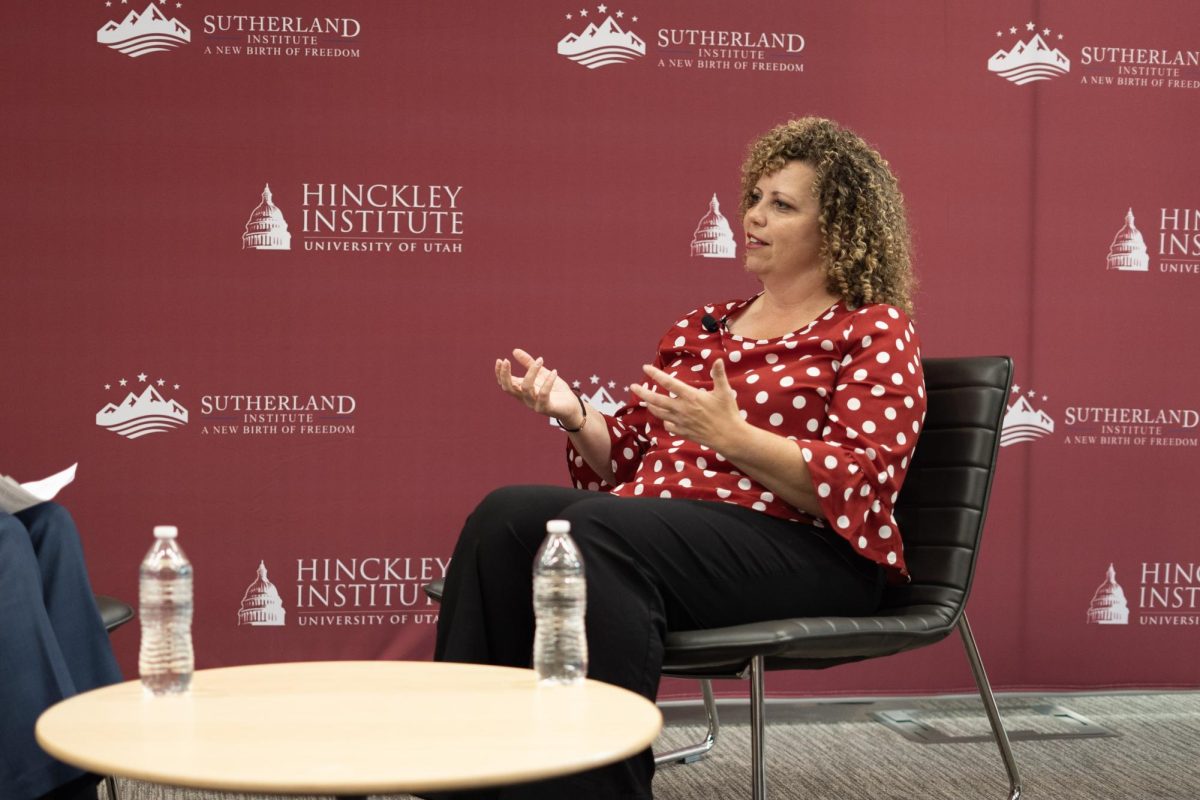This story is published as part of U.S. Democracy Day and the Utah College Media Collaborative, a cross-campus project bringing together emerging journalists from Salt Lake Community College, the University of Utah, Utah State University and Utah Tech University.
Federalism is the name of the game, and Rep. Celeste Maloy reminded Utahns why during her conversation at the Sutherland Institute’s 2024 Congressional Series last Wednesday.
Maloy sat down with University of Utah students, locals and U staff on Sept. 4 to discuss her thoughts on the federal government’s influence on state and local policy. She covered land use, the Chevron decision, guidance letters, environmental regulation and the importance of transparency in congress.
“I think transparency and accountability are key in government,” Maloy said. “I think a lot of that transparency is actually baked in, but you have to know where to look and what you’re looking for, and so, that really isn’t transparency.”
Balancing Federal and State Jurisdiction
Maloy said the government’s main function is to protect the freedom of individuals. She explained that more often than not, people are not consuming news at the local level, and instead have a tendency to focus on issues at the federal level. In reality, she added, state, county and city governments are just as important.
To ensure that the balance between federal and state jurisdiction is maintained, Maloy introduced the Full Responsibility and Expedited Enforcement (FREE) Act in June. The FREE Act requires government agencies to evaluate its permits and assess if they are appropriate for permit by rule. Permit by rule is a process by which gas and oil sources are regulated.
Maloy said this act is meant to streamline the permitting process, but it has not yet moved past being introduced in the legislature.
Additionally, Maloy said she believes that overturning the Chevron decision will help maintain the balance.
According to the Public Policy Institute of California, the Supreme Court’s 1984 decision in Chevron v. Natural Resources Defense Council states that if federal legislation is ambiguous, courts must refer to an agency’s interpretation of the legislation. This holds true even if a court disagrees with an agency’s interpretation.
“In the 40 years since [the decision], that deference has gotten broader and broader to where I would say the agencies are often interpreting their authority to be clearly in violation of what Congress said,” Maloy said.
Maloy explained that in her opinion, states do most things better.
“With a lot of the hot-button political issues, part of the reason they are so hot is because we’re trying to solve them at a federal level when it would make more sense for states to make decisions,” Maloy said. “States are much better at figuring out a solution that works for their state.”
Federal Policy Decisions
The conversation’s moderator, William C. Duncan, the Sutherland Institute’s constitutional law and religious freedom fellow, asked Maloy about the role of guidance letters in Congress. Guidance letters offer the public information on legislation by explaining its effects. They can also outline interpretations of legislation.
Maloy said she believes guidance letters are “infringing on the idea of federalism.”
She explained the solution to issues surrounding guidance letters begins with the language Congress uses in a bill. Ensuring that the intended message within a bill is clear to understand would eliminate the need for guidance letters.
“I think we owe it to the court and the agencies to be really clear, and we don’t have to be tricky about it, we can be really open about it,” Maloy said.
Federal Land Use
When Duncan asked about land use, Maloy touched on Utah filing a landmark public lands lawsuit against the U.S. Supreme Court. The lawsuit asks the Court to address whether the federal government can hold on to unappropriated lands indefinitely. In Utah, approximately 18.5 million acres of land is unappropriated. This land is currently managed by the Bureau of Land Management.
Maloy said that the 18.5 million acres in question are managed for grazing, mining and hiking. She explained that land in national parks is not included in the lawsuit.
“I don’t know what the court’s going to decide, but I do think it’s better that local voices are involved in those conversations,” Maloy said.
Maloy also brought up permitting challenges surrounding land use. She said the federal government is inefficient when it comes to permitting because the states typically have deadlines they are required to make a decision by. However, the federal government rarely has these deadlines. At the federal level, the permitting process can take years, which costs taxpayers.
Maloy gave the Northern Corridor in Washington County as an example. The road has been on the county’s transportation plan for more than 20 years. It requires federal permits because it goes through federal land.
“There are people in federal agencies that just don’t think you should have a road there, and so they don’t issue the permits,” Maloy said.
The Omnibus Public Land Act of 2009 instructed the BLM to consider giving Washington County a right of way to address the Northern Corridor’s future. However, permits were not granted. Taxpayers continued to pay for the county to keep working on obtaining permits until January 2021, when the highway was approved.
Alina Walker reported and wrote this story as a journalism student with The Daily Utah Chronicle at the University of Utah. Her article is part of U.S. Democracy Day, a nationwide collaborative on Sept. 15, the International Day of Democracy, in which news organizations cover how democracy works and the threats it faces. To learn more, visit usdemocracyday.org.




